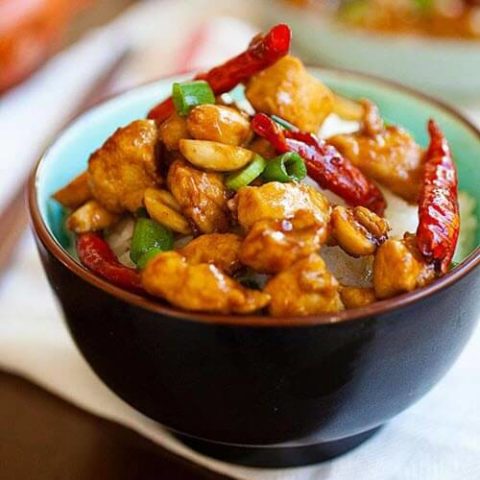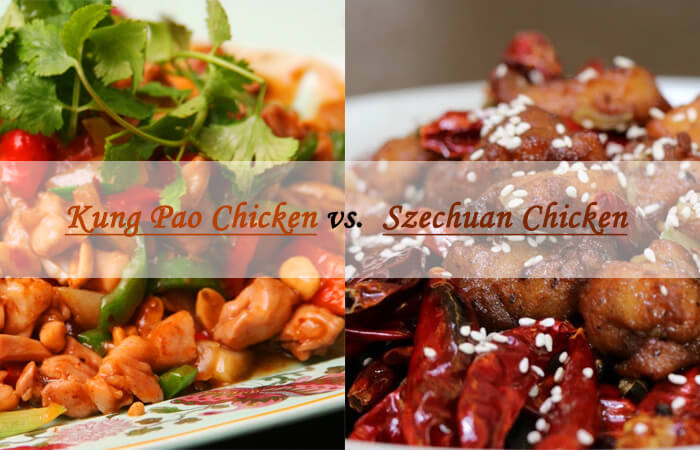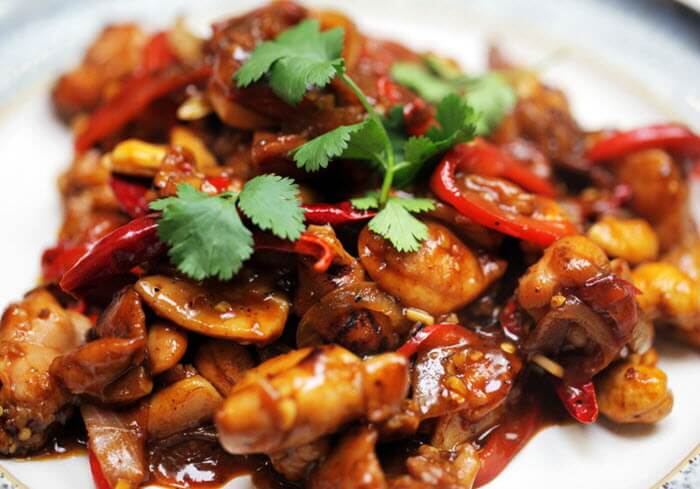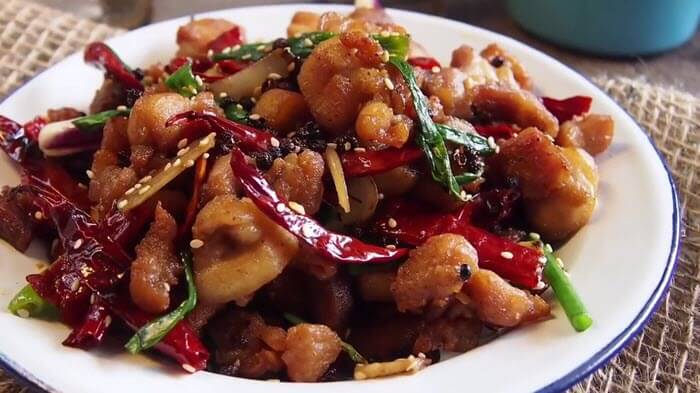Although Kung Pao Chicken and Szechuan Chicken look similar at first glance, they’re different from one another.
10-Second Summary
Kung Pao Chicken has a more nutty and sweet taste. In comparison, Szechuan Chicken tastes sweet and sour, and has its spiciness as its forefront flavor.
They also use different types of chili peppers. The former uses dried chilis or red bell pepper. And the latter uses Sichuan peppercorns.
Table Of Contents
What is Kung Pao Chicken?
Kung Pao Chicken is a spicy, stir-fried dish made of chicken meat, veggies, peanuts, and lots of seasonings. Although it’s a spicy dish, It’s more known for its nutty and sweet taste.
It’s originally from Sichuan, China. And is traditionally served as a side dish in Chinese banquets.
However, when the first Chinese immigrants came to the US and introduced Kung Pao Chicken to the locals, it became a staple Chinese takeaway. Now, you can find it in many Chinese restaurants, even outside China and the US.
The dish name “Kung Pao” is derived from “Gong Bao,” which means “palace guardian” in China.
Apparently, there was a Gong Bao named Ding Baozhen who loved to eat and serve this dish to palace visitors. So, people just naturally associated this dish with him. To the extent that they named this dish after him.
Recipe
Kung Pao Chicken is a savory and hearty takeout dish that’s well-loved in many countries. It’s rich in flavor and has tons of filling ingredients.
But contrary to what many people may think, cooking Kung Pao Chicken is easy and simple.
So, if you miss munching on a bowl of Kung Pao Chicken, here’s a simple homemade recipe you can follow.

Homemade Kung Pao Chicken Recipe
The most popular Kung Pao Chicken recipe.
Ingredients
For the Marinade
- 2 teaspoons cornstarch
- 1½ teaspoon soy sauce
- 1½ lb skinless chicken breast
- 1 tablespoon Shao Xing wine or dry sherry
For the Kung Pao Sauce
- ¼ ground ginger
- 1 tablespoon sugar
- 2 teaspoons soy sauce
- 1 tablespoon cornstarch
- 1 tablespoon sesame oil
- 1 tablespoon hoisin sauce
- ⅓ cup water or chicken broth
- ½ teaspoon dried red pepper flakes
- 1 tablespoon Chinese black vinegar or balsamic vinegar
For the Stir-fry
- 5 thinly sliced scallions
- 1 diced red bell pepper
- 3 chopped garlic cloves
- 2 thinly sliced celery stalks
- 2½ tablespoons vegetable oil
- ⅓ cup roasted, unsalted peanuts or pine nuts
Instructions
Step 1: Chop the chicken meat into bite-sized pieces.
Step 2: Wish together the marinade sauce ingredients in a medium bowl. Make sure that the cornstarch is fully dissolved.
Step 3: Toss the chicken meat into the mixture. Ensure that all sides are well coated. Then, set it aside.
Step 4: Grab another bowl and whisk all the Kung Pao sauce ingredients together. You may adjust the measurements to your preference.
Step 5: Place a wok or skillet on the stove, and set it over high heat. Then, pour 1 tablespoon of oil to coat its surface.
Step 6: Toss the cut bell pepper and celery into the wok or skillet. Then, add a pinch of salt to taste.
Step 7: Stir the vegetables until they start to brown. Once done, transfer them into a bowl and set them aside.
Step 8: Pour ½ tablespoon of oil into the wok or skillet. Then, toss the chicken meat. Once its bottom starts to brown, turn them over to cook the other side. You may want to divide them into 2 or more batches to not crowd the pan.
Step 9: Once the last batch of your chicken is cooked, add another ½ tablespoon of oil. Then, toss the scallions and garlic gloves for about 30 seconds.
Step 10: Add all the cooked ingredients into the wok or skillet. That includes all the chicken meat and the Kung Pao sauce mixture.
Step 11: Lower the heat to low. Then, stir the ingredients for about 30 seconds.
Step 12: Toss in the roasted peanuts.
Step 13: Continue stirring until the sauce thickens and the dish becomes warm. Then, finally, serve.
Nutrition Information:
Yield: 4 Serving Size: 1Amount Per Serving: Calories: 576Total Fat: 29gSaturated Fat: 4gTrans Fat: 0gUnsaturated Fat: 22gCholesterol: 146mgSodium: 745mgCarbohydrates: 18gFiber: 3gSugar: 8gProtein: 59g
What is Szechuan Chicken?
Szechuan Chicken is another spicy, stir-fried Chinese dish. Which is known for its spiciness that may leave your mouth burning. Thanks to the Sichuan peppercorns used to complete and perfect the dish.
It’s also a popular Chinese takeaway in many countries, including the US.
And this one also originates from Sichuan, China. In fact, the dish name “Szechuan” is derived from that district name, “Sichuan.”
Fun fact: Sichuan gets cold during the winter and autumn seasons. So that explains why a lot of their dishes are warm and spicy.
But the good thing about this dish is you can customize it to the level of hotness you can take. And yes, without compromising its savory and unique flavor.
Recipe
If you’re craving a similar chicken dish but spicier, try this Szechuan Chicken homemade recipe.
This recipe is full of spice that’ll surely excite your taste buds.

Homemade Szechuan Chicken Recipe
Make your own Szechuan Chicken at home!
Ingredients
For the Marinade
- 2 slices ginger
- 1 tablespoon salt
- 4 pieces chicken thighs
- 1 tablespoon soy sauce
- 1 stack shredded scallion
- 3 tablespoons cornstarch
- ½ tablespoon white pepper
- 1 tablespoon Shao Xing wine or any Chinese rice wine
Other Ingredients
- 4 slices ginger
- 50 dried red chilis
- ½ teaspoon sugar
- 5 chopped red chilis
- 1 stalk chopped scallion
- 1 tablespoon sesame oil
- ⅓ cup peanuts (optional)
- 1½ tablespoon of vegetable oil
- 2 tablespoons Szechuan peppercorns
- ½ tablespoon Shao Xing wine or any Chinese rice wine
Instructions
Step 1: Cut the chicken thighs into bite-sized pieces.
Step 2: Whisk all the marinade ingredients into a medium bowl.
Step 3: Add the bite-sized chicken meat into the marinade mixture. Then, set it aside for about 10 minutes.
Step 4: Add a teaspoon of oil into a heated wok or skillet. Then, use it to coat the surface.
Step 5: Toss in the chicken meat, and cook it until golden. Divide it into 2 or more batches to ensure that the meat is cooked evenly. Once cooked, set it aside.
Step 6: Add another half teaspoon of oil into the wok or skillet.
Step 7: Fry the Szechuan peppercorns and dried red chilis until fragrant.
Step 8: Add peanuts, scallions, and ginger. Then, stir for 60 seconds.
Step 9: Pour in the Shao Xing wine, sugar, sesame oil, and cooked chicken meat. Stir until the meat is well coated.
Step 10: Garnish with more scallions. Then, serve.
Nutrition Information:
Yield: 2 Serving Size: 1Amount Per Serving: Calories: 16865Total Fat: 1003gSaturated Fat: 312gTrans Fat: 1gUnsaturated Fat: 441gCholesterol: 3105mgSodium: 58441mgCarbohydrates: 864gFiber: 74gSugar: 150gProtein: 1066g
Differences Between Kung Pao Chicken and Szechuan Chicken
Kung Pao Chicken and Szechuan Chicken are both spicy, stir-fried Chinese dishes. Not to mention that they look the same and are presented similarly.
Still, they have a few notable differences that make them unique from each other. And here are three of those:
Differences | Kung Pao Chicken | Szechuan Chicken |
Ingredients | Chicken, vegetables, nuts, and red peppers, etc. | Similar ingredients but use hotter peppers |
Taste | Sweet, spicy and nutty flavor | Spicy, sweet and sour |
Hotness level | Less hot | Hotter |
Ingredients
At first glance, you’d see pieces of bite-sized chicken meat, veggies, and chilis on both dishes. Which makes them hard to differentiate, especially if you’re unfamiliar with Chinese cuisines.
But there are a few particular ingredients that set them apart.
Kung Pao Chicken
You can find bite-sized chicken, dried chilis or red bell pepper, scallions, celery, and peanuts in a Kung Pao Chicken dish.
It also uses several spices and seasonings to achieve a sweet and salty taste. And that includes Shao Xing wine, hoisin sauce, ginger, soy sauce, and sugar.
Szechuan Chicken
Szechuan Chicken uses almost the same ingredients, spices, and seasonings. They just varied on the measurements.
One thing that makes it different is it uses Sichuan peppercorns and red chilis to make the dish spicy. Which makes it comparatively hotter than Kung Pao Chicken.
Taste
Although they use almost the same ingredients and are cooked similarly, the two surprisingly have unique flavors of their own.
Kung Pao Chicken
Because of peanuts, a Kung Pao Chicken dish has a notable nutty flavor. You can taste it as soon as you grab a mouthful since it’s used as a garnish.
Although it has dried red chilis, its sweetness and saltiness overpower its hotness. That is more true in the American-version Kung Pao Chicken which uses red bell peppers as alternatives.
Szechuan Chicken
On the other hand, Szechuan Chicken is known for its spiciness. And that’s because it uses Sichuan peppercorns that are hotter than dried red chilis and red bell pepper.
It’s also important to note that although some recipes include peanuts, Szechuan Chicken doesn’t taste nutty at all. Instead, it has sweet and sour flavors.
Hotness level
Both Kung Pao Chicken and Szechuan Chicken are spicy dishes. But one is significantly hotter than the other.
Kung Pao Chicken
A classic Kung Pao Chicken uses dried red chilis to spice up the dish. And that kind of pepper has 500 to 2,500 Scoville units, which is considered “medium.”
But American-version recipes use red bell peppers, which are considered “mild.”
Szechuan Chicken
In comparison, Szechuan Chicken uses Sichuan peppercorns that have 50,000 to 75,000 Scoville units. Which is part of the “hot” category.
That said, Szechuan Chicken is comparatively hotter than Kung Pao Chicken.
Related Posts



